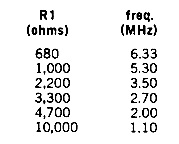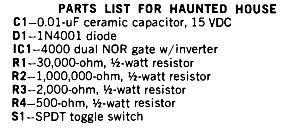This post will present many simple ad easy circuit projects which can be built at home by children, school students and all hobbyists.
Let's begin with the circuit diagrams:
Waveform Generator
The simple project is a multipurpose quad op amp LM3900 (or MC3401) can be simply convinced to provide two various waveforms through two of its portions, reserving the other two for mixing or amplification uses.
Section one is an integrator, furnishing an excellent triangular waveform, another unit gives a square wave signal.
Adjusting R6 differs both frequency and duty -cyle (symmetry) of the two waveforms.
A C1 value of .001 uF will offer a frequency of approximately 1 kHz, even though .01 uF will probably be in close proximity to 100 Hz.


Simple Pulse Generator
Require a simple square wave generator for a lot of digital projects? This particular quad NOR gate 4001A CMOS chip which is often effortlessly received, stands all set to complete the task with great efficiency.
Be aware the two pots, R1 and R2. These control both frequency and duty -cycle (symmetry), via diodes D1 and D2. C1 establishes the complete frequency range.
A C1 value of 0.1 uF, constitutes a range of around 11 to 2500 Hz. Employing a 0.2 uF value, the range is approximately 4 to 700 Hz.
The rest of the two gates (pins 8 -13) work as buffers, to segregate the oscillator from the results of circuit loading. Duty cycles of nearly 10 to 1 can be acquired.


Quicker Than The Eye Game
The quicker you are able to consistently press S1, the quicker the segments of the digit "8" will fly across the LED display.
The fun of this quicker compared to eye game circuit project would be to find out if you possibly can make the 8 look like a solid number.
We certainly have in this article the essential multiplex principle employed in calculator displays.
In calculators just one segment of a digit is on at any given time, however the rapid change causes it to be seem that every are on. Pin 6 previously mentioned is employed to reset to zero.


Simple Casino using 7 Segment LED
The simple counter display circuit of the "Quicker Than the Eye" project could be designed to a game of chance for up to seven players, with a built -in provision to guarantee that "The House Never Loses."
Be aware that all seven display segments, just like the previous circuitry, have only one connection. Three outputs (pins 8, 9, 10) now go to the decimal point, through isolating diodes D1, D2, and D3.
This provides "The House" a 3 out of 10 possibility to consider all bets. The clock ought to be fixed at provide a quickly flickering display when the push- button switch is depressed.
Once the player holds down the simple casino switch for a few seconds and relieves it, one of the segments, or the decimal point will continue to be lighted … and the odds are on the Point!


Sine Wave Generator
The 741 op amp has developed into a classic for IC designers. In this article it is as a Parallel T audio oscillator, controlled from a single power supply, which is often a 9 volt transistor battery.
Remember that the frequency of the sine wave determining resistors and capacitors are fixed within the ratio of C1 = C2, C3 = 2 x C1 and R1 = R2, R3 = R1 x 0.1.
To vary the frequency, all three pots ought to be ganged, but a fair degree of adjustment could be achieved by varying R3 by itself, even though output amplitude will drop on each side of the optimum value.


Single Supply Signal Shifter
Op amps, such as the popular 741, are often managed with matching plus and minus power supplies.
On the other hand, for easy signal amplification applications, the single positive supply demonstrated below continues to be located to function pretty perfectly.
Resistors R3 and R4 might be fixed at about 5000 ohms each, or substituted along with a 5K or 10K potentiometer, if it is needed to adjust the no- signal output level so that high -amplitude signals will never be clipped.
Occasionally, intentional clipping is preferred, which means this feature could be maintained for general experimental applications.
Take note: If a potentiometer is utilized for R3, R4, link center terminals of pots to pin #3 of IC1.


Micro Mini Power Amplifier Circuit
Developed for extremely private listening, this little and easy to build power amplifier project sports a tiny loudspeaker of 11/2 to 2 inches diameter.
The gain might be varied with the feedback resistor through about 1 to 100. Merely a single power supply, which might be a nine volt transistor radio battery, is essential.


Simple Radio Circuit - Crystal Set
A 741 mini power amplifier can revise all those 1N34 "cat's whiskers" crystal receivers directly into the Space Age.
Based on antenna and ground facilities, good reception is achievable with clear volume through the tiny speaker.
A 9 volt transistor battery supplies portable radio circuit convenience for getting away the frustrations of the IC experimental test bench, for one thing!


Crystal Controlled CMOS Oscillator
An affordable crystal is the color -control TV crystal, functioning at somewhere around 3.58 MHz.
With the simple circuit demonstrated under, a handy signal, ideal for dividing down to several frequencies, along with a 60 Hz reference for portable clocks, is effortlessly acquired.
Unused gates through the 4001 quad -NOR chip are employed as buffers.


Audio Mixer
When a wide variety of audio signals need to be mixed or blended, isolation ought to be taken care of amongst the originating sources.
Making use of the nearly similar LM 3900 or MC 3401 quad op amps, twelve organ tone generator outputs were put together into one output by way of one section.
In the circuit listed below, signals of 4 to 5 volts peak amplitude were mixed at unity gain. Resistor R2 is generally twice the value of feedback resistor R3, however it could be varied to shift the output level and prevent or intentionally present waveform clipping.


Sun Up Alarm Clock
Phototransistor Q1 is quite delicate to light. The sun shining within this small device will result in a 100 Hz tone to awaken you each morning.
You might as well make use of it in a large number of different ways, just about anywhere you would like to sense a light beam.
Light left on in the garage? Headlights operating? This particular circuit could be the begin of fascinating thoughts. The base of Q1 is not really linked to nearly anything.
The speaker could be a small 8 ohm unit and you will probably discover that a small 9V transistor radio battery is effective and continues quite a long time.


Organ Plus Tone Generator
Musical organ like sounds could be created with this particular CMOS circuit.
The IC produces an almost square wave output through pin 11 and also the spacings on which output stream of pulses could be varied by changing R1 and R2.
In case you change them efficiently, you can aquire a slide -trombone result. Outputs A, B, and C differ from the pin 4 output in that the square wave at this point turns into a sawtooth, a spike and a complex mixture of both equally.
Rich overtones result that you can hear along with the 8 -ohm speaker.


Quick Draw
The object of "Quick Draw" is to test your reaction time towards your opponent's.
A third person works as referee and commences the duel by pressing Si, which usually lights LED D1.
On witnessing D1 illuminated, you attempt to outdraw your opponent by moving S2 (or S3) from "holster" to "draw" before he does.
If you do, D2 (or D3 if you are using S3) will certainly light first and may instantly avoid the other LED from illumination.
A clear champion anytime.


Pulsed Alarm
This particular circuit is perfect for driving alarms mainly because it pulses the bell or buzzer using a frequency you can choose through R1 and R2.
The pulsing action not merely receives attention quicker, but preserves battery power in addition, considering that the alarm can easily function much longer.
And also the charm of this circuit is its low power consumption. In the off state, prior to the panic switch S1 is thrown, the circuit employs microwatts of power, so it can sit all set for months.
That's one of several gems of CMOS.


LED Blackjack
The object would be to view who are able to get nearest 21 LED flashes without having going through. Several people can easily play. Press S1 until D2 begins flashing (1 second on, 1 second off) .
Then count the number of pulses just after S1 is released. You can receive 5 initially. That is certainly just like being dealt a 5 in Black Jack.
Repeat the process and add the second count to the first, etcetera, unless you are as near since you can easily reach 21 without going through.
In case you go over, you might be out of the game. A fun game and simple to make circuit project.
The 9 volt battery can last for months.


Automatic TV Turnoff
This particular small circuit can help you save steps, time, and electricity.
Once you leave a room and switch off the lights, for instance, this circuit will sense the fact that lights are off and may activate the relay coil.
Use it switch off the TV, hi -fi, or any other light within room while not disturbing with extra house wiring.
You might as well make use of the circuit to help keep thieves away. With Q1 sitting at the window, it is going to switch on house lights once the sun falls.
R1 and C1 maintain the relay functioning for a minimum of one -half second to prevent bouncing of the relay contacts.


Crazy Flasher
This particular small yet outrageous flasher circuit will drive you insane, specifically if you make R1, R2, R3 and R4 variable resistors.
LED D4 will show a few wild beats. For a wild party effect, connect a SCR instead of D4 and drive a spot light.
Incorporate along with disco music and you have a crazy light flashing scene!


Auto Burglar Alarm
This easy burglar alarm circuit will sound your car horn anybody opens your car door.
The timers permit you to depart and get into the car without the horn sounding.
To set, or arm, the alarm circuit, open S2. This will likely provide you with five seconds (R1, C1) to acquire away and close the door behind you.
Anybody opens a door for two seconds (R3, C2), the horn will sound and will remain locked on till SI is opened.
In case you open the door to get into, you might have two seconds to shut S2, which can be sufficient time if S2 is effortlessly placed.


Car Wiper Controller Circuit
At any time hold the trouble of not being able to make your car wipers go slow enough? And quite often, do you need to just press a button to make wipers flip one time? This particular circuit does indeed both.
Set S2 to the mode you desire. In case you choose "repeat ", then R3 will figure out the time be tween wipes (up to several minutes), so place R3 on a knob you can switch although sitting in the driver's seat.
R5 will manage the length of the wipe; you simply set it once for your car. If S2 is set to "single wipe ", then pressing S3 will certainly kick the wipers up as soon as.
An extremely easy circuit project.


Light Meter
The best thing about this light meter circuit is that it is practically flawlessly linear over a large variety of light inputs.
It offers you with the simple function of a camera light meter and will be designed to go through straight in f -stops and shutter speed.
Phototransistor Q1 detects the light level and goes by that about the 741 op amp in which the small voltage is amplified.
Meter M is any you actually have throughout the house, or any type of affordable meter you can purchase.
Unless you have a meter, view the meter eliminator circuit. R1 offers a zero adjustment for the meter.



Unknown Voltage Level Indicator
This specific circuit highlights the importance of a digital voltmeter and in actual fact offers a extremely vulnerable, high impedance meter for your workbench.
The LM 339 is an IC comprising four separate operational amplifiers of a special type. These types of op amps compare the reference voltage set on one input pin having an unidentified voltage on the other.
In case the unidentified voltage surpasses the reference, the output will go higher and lights an LED. D1 lights first.
Along with a somewhat higher input voltage, D2 will light, etc. Variable resistor R5 permits you to set the voltage guidelines amongst D1, D2, D3 and D4 through around .02 volts per step to around 0.5 volts per step.


Dog Howling Sound Simulator
This howler simulator circuit will certainly develop a loud dog like howl that starts off solid and gradually grows weaker and weaker until it finally stops.
To begin it all over again, simply press Si. A good choice for alarms, bicycle horns, a different type doorbell, or as a Halloween trick.
Changing R4 will change the frequency, or pitch of the howl, however the main reason for R4 is to set the filter circuit into oscillation using the op amp.
Adjust R4 till oscillations commence. The output should go to an amplifier rather than just to a speaker directly considering that the result is way better.


Op Amp Wink Circuit
This small op amp flip flop circuit brings about the two LED's to alternate winking everytime S2 is pressed. It is a very quick reaction circuit.
If S2 is bounced even the slightest amount, the LEDs will flip. Whenever you think you might be pressing S2 only once, as a result, you might observe D1 and D2 flip over and over again.
That is switch bounce in S2, a common issue in the computer world. You possibly can link an oscillator instead of S2 which will allow D1 and D2 to beome dual flashers.
Either replace S2 with a relay driven by the oscillator, or link the oscillator output amongst C1 and pin 7.


TTL Power Supply
This kind of IC project presents to you a flat, ripple free,. and locked -on 5 volts for almost any use in your home or on your work bench.
It will eventually end up being really convenient for the TTL projects outlined in this article i.e., those projects making use of any kind of IC starting with the two numbers 74.
The LM309 is a amazing IC made up of more than a dozen transistors as well as some diodes.
It may cope around 1 amp without having a heat sink. In case you mount it on a heat sink, a 4 by 4 inch bit of aluminum will work, it may supply around 4 amps without dropping its 5 volt output.


Capacitor Match Maker
This specific helpful, yet easy circuit will assist you to match two capacitors or to tell if one has greater capacitance compared to other.
Assume you might have one capacitor of known value, say 1 uF. Place it exactly where C1 is in the circuit.
Assume you might have one more capacity of some not known value. Place it just where C2 is in the circuit.
At this point flip Si from "set" back to ground. After that press S2. If D1 goes off and D2 goes on, it indicates C2 is less than C1, for instance 0.5 uF.
If D1 remains on and D2 off, it indicates C2 is equal or greater than C1. You can utilize this circuit to assist you swiftly to go through a pile of old capacitors.


Lightning-Speed Reaction Tester
The following circuit utilizes the two flip -flops of the CD 4013 incorporated circuit to test your eyesight.
Begin by moving S1 from ground to "set" and back to ground. This will likely light D1 and D3. Now press S2.
D1 and D3 will go off and D2 will go on, but D3 must turn off somewhat later than D3 because of built -in delays in the circuit.
Are you able to view the variation in the two LED's? This will make a fantastic experiment for children to take to school.


Pulse Stretcher
Ever before really need to stretch a pulse? Possibly you cannot quite pull up a self -latching relay, or possibly your bike -blinker is on not enough and off too much.
It could be designed more time by increasing R1 or C1. Almost all unused pins of the IC ought to be grounded.


High Frequency VCO
Simply by varying the control voltage (a separate battery) amongst 1 and 25 volts, the output frequency of this oscillator will change between around 500 Hz and 50,000 Hz.
There are a host of experimental applications, like putting a microphone in series using the control voltage and getting the output frequency go into an amplifier and speaker.
Voice -like singing sounds can be made. Or run the output of an electric guitar into the control voltage input and hear the music!


Octave Music Maker
This particular circuit presents you with musical octaves which are perfectly modelled through the top octave which you feed as an input.
Setting up any tone, such as the tone from an electric guitar, or from an organ, or from a CMOS oscillator, can cause C4 to be four octaves lower, C5 to be five octaves lower, and so forth.
Output A is a specific waveform that is a saw -tooth composed of octaves which are one, two, and three times less than the input.
The sounds of such outputs could be changed with resistor and capacitor circuits prior to feeding into your hi -fi.


Clean Switch
Presently there is almost nothing more intense in a circuit compared to a noisy switch.
Even the slightest bounce may cause a double "on" and lead to double digits on your calculator display, or extra pulses into a million dollar computer system.
What exactly to perform? This particular circuit indicates the fundamental concept employed through the entire computer industry.
The CD 4001 NOR gates are connected in flip -flop fashion in order that as soon as they flip, they will remain in that positions.
Double bounces continue to result in a single, solid "on" pulse at the output.


Multi-Input Music Synthesizer
The inputs to this particular synthesizer could be through any kind of musical instruments. C4 could be from an electric guitar, C5 from an electronic organ, etc.
Or the inputs can be from the outputs of the "Octave Music Maker" project. The voltage ought not to surpass 9 volts at these types of inputs.
The output might be a mixture of the inputs, in which control the incorporating through the switches.
The switch marked "Si" will certainly place the C4 input through to the output when it is turned to the down position.


Touch and Flip
Ever before thought about touch plate, just like the type you observed on some elevator buttons, functions?
This specific circuit will provide you a great feel for how the touch plate functions in a circuit and enables you to experiment further.
The plate could be simply a small piece of metal or aluminum foil. Begin by sliding S2 to "set" then back to R3.
At this point press Si. LED's D1 and D2 will flip. Now touch the plate to flip them back.
The sensitivity of the simple touch plate would depend on humidity in the room and on R3 and C1.
You are able to experiment with these in several techniques.


Code Practice
Boning up for your Amateur code exam? Pushbutton S1 constitutes a extremely affordable Morse code key.
The tone out of the circuit, at point A, can drive an amplifier or a pair of high- impedance headphones.


Rain Detective
Do you have some issue with water from time to time? Attempting to maintain rain from destroying your top -down convertible?
This small rain detector circuit will certainly sound an alarm when rain gets amongst the aluminum foil strips to help keep you high and dry.


Open Sesame Auto Alarm
This kind of easy auto alarm enables you to utilize either commonly open switches (such as on the ignition or a door button) or generally closed switches (just like on a hood or a radio switch).
Or even, both can be utilized at the same time. The relay coil will certainly function and also the contacts enables you to blow the car horn, or to work a siren circuit.


Low Z Mike Booster
This small and easy low impedance microphone circuit provides the property of being capable to pass adequate current to be directly in the feedback path of this 741 amplifier.
The gain is controlled by changing R1. This specific circuit can feed within your hi -fi unit to provide higher power output.


Alternate Action Button
The pushbutton at "A" will result in the relay with this circuit to go off one time it is pressed, and cause the relay to go on the very next time the button is pressed.
To put it differently, the pushbutton has different action. Very first it creates an "off ", and later, an "on".
This sort of circuit is extremely convenient for projects around the house. All unused pins ought to be grounded.


Sine Wave Generator
Believe that it is achievable to possess a pulse stream converted into a good smooth sine -wave?
This specific circuit will perform it! The truth is, you could have the most affordable sine -wave frequency you can think about by gradually pressing a button to create your own manual pulse stream, if you'd prefer.
The IC is a counter which has been designed to divide the input pulse rate by ten.
The outputs feed by means of resistors R1, R2, R3, and R4 to develop a sine wave.


Ignition Key Tone Generator
This particular ignition key tone generator eliminates the loud, annoying buzzer in your car with a attractive tone of around 2000 Hertz.
One section of an LM3900 quad operational amplifier is linked as a square wave generator, which can be rich in harmonics and constitutes a pleasing sound.
Current amplification to drive the speaker is made available from Q1. The frequency of oscillation is dependent upon C1 and R2.
Entire current drawn through the circuit is approximately 75 milliamperes at 12 volts.


Continuity Checker
Once wiring a new electronic project or troubleshooting an old one, it is usually a wise idea to produce numerous continuity checks to be assured that particular connections in the circuit are right.
In the days of vacuum tubes this has been completed with an ohmmeter, however for today's solid state circuitry you may not employ the majority of ohmmeters for a number of purposes.
A few ohmmeters possess excessively a lot battery voltage and provide around hundreds of milliamperes into a short circuit. This could effortlessly harm costly solid state devices.
Additionally, the ohmmeter is an unreliable technique to measure circuit continuity, due to the fact it will certainly examine an emitter -base or diode junction.
This particular continuity checker is a useful equipment for troubleshooting circuits, and is also dependable on any kind of solid state device or circuit.
The maximum voltage at the input terminals is around 40 millivolts, and negligible current is that passes the circuit when continuity is mentioned.
The circuit will never point out continuity for resistance values of around 35 ohms or greater, and may not register through an emitter -base junction or diode.
The simple circuit is powered by a standard 9 volt transistor battery and draws about 1 milliampere once the input leads are open.
Shorting the lead leads to an audio tone to be created and draws about 15 milliamperes of battery current.


Burglar Alarm
This kind of burglar alarm circuit employs one integrated circuit and functions from a 6 volt battery.
It is activated upon the breaking of a circuit. Considering that the sensing loop works in a high impedance circuit, you can find almost no limit to the length of wire you need to use.
You can protect every window and door at your residence. Practical operation by utilizing four D cells for power is achieved by making use of a four -section CMOS integrated circuit which usually draws just a few microamperes through the battery.
Therefore, battery life will probably be similar to its shelf life except when the alarm is turned on.
The heart of the circuit is a pair of NOR gates linked in a bistable configuration known as flip -flop or latch circuit.
Once the circuit is within standby, pin 1 of IC1 is placed to practically zero volts through the continuons loop of sensing wire.
This leads to pin 3 to assume a voltage of 6 volts, cutting off Q1 and Q2. Once the sensing circuit is broken, C1 charges to battery voltage via R2.
This leads to the latch circuit to change state and pin 3 would go to zero volts. 131 becomes forward- biased by means of R4 and activates 02 which will functions the buzzer.
The easy circuit will continue to be in an activated state as soon as the alarm is set off, however the broken circuit is renewed.
A reset switch has been offered to return the latch circuit to its original state and turn off the alarm.


Telephone Pickup
You possibly can pick up and amplify the voice signals from your telephone employing this simple IC circuit and a small pickup coil.
The circuit has adequate output to drive a loudspeaker. One portion of a quad op amp is employed as a high -gain voltage amplifier.
This enhances the fairly low output of the pickup coil (a few millivolts) to a satisfactory level to drive the loudspeaker.
The circuit draws around 60 milliamperes from a 12 volt power source.
You can acquire a predesigned pickup coil or build one particular on your own utilizing around 200 turns of fine enamel wire wound around an iron core.
Position the pickup coil close to the telephone receiver for most effective benefits.


Guitar Tuning Aid
If you take benefit of the frequency stability of the 555 timer IC operating in an astable mode, an oscillator could be designed which may be employed as a tuning aid for the guitar.
The first string of the guitar, E, constitutes a note with a frequency of 82.4 Hertz. The frequency of the oscillator is set to twice this value, 164.8 Hertz, after which accompanied by a divide -by -two stage to generate the specified frequency.
The reason for the divide -by -two stage is to make certain that the waveform generated includes a duty cycle of precisely 50 %. This constitutes a note without any second harmonic distortion.
The frequency of oscillation of the circuit is placed by adjustment of R1, R2, and C2 also determine the frequency of oscillation but these components are fixed values and need no adjustment.
The output of IC2 is fed to an emitter follower to deliver current gain to drive a loudspeaker. C3 acts as a low -pass filter to attenuate harmonics and create a more natural sounding note.
The circuit is powered by a 5 volt supply, and this voltage ought to fall around the range of 4.75 to 5.25 volts for IC2 to work effectively.


Negative Power Supply
Numerous functional amplifiers work from a dual - polarity power supply. For low current applications, it might be much easier to develop this negative power supply making use of one IC, instead of correcting from the power line or transformer.
IC1 functions in an astable mode along with fundamentally square wave output at pin 3. C2, C3, D1 and D2 form a full -wave voltage doubler circuit which generates around minus 14 volts without any load at the negative output terminal.
The particular circuit will certainly provide 12 volts into a load of 1000 ohms.


Dual Polarity Power Supply
Several functional amplifiers necessitate both positive and negative supplies for correct operation.
With this particular basic circuit you could make a floating power supply and transform it right into a dual polarity supply.
To deliver ±15 volts since many op amps need, you will require a 30 volt supply to drive the circuit.
The output voltages of this particular circuit are usually set by the voltage divider action of R1 and R2 and therefore are properly managed.
Current output is fixed simply by the unbalance amongst the loads on the positive and negative outputs, and it should certainly not surpass the rating of the transistors, 200 milliamperes.


Automotive Over-Speed Indicator
The speed of an automobile could be pointed out by revealing the pulses developed through the ignition system and triggering an LED to light.
This specific circuit employs 2 NOR gates linked like a one shot multivibrator which usually constitutes a set duration pulse everytime the primary circuit of the automobile ignition system opens the circuit towards the ignition coil.
The two remaining sections of the IC are employed as buffers which provides a precise rectangular pulse to the integrating circuit consists of R3 and C4.
Since the number of pulses per second raises, the voltage fed to the base of Q1 gets to be sufficient to trigger Q1 to carry out and light the LED.
The speed from which LED 1 lights is placed by adjustment of R4. To position the circuit in operation, link the input terminal (R1) to the distributor side of the ignition coil or to the tachometer connection on those cars equipped with electronic ignition.


Power Mike Amplifier
A well known accessories to a CB radio is a power microphone. This kind of circuit delivers an adjustable gain of 1 to 10 which could boost the output of a powerful microphone for higher modulation levels without screaming.
The particular circuit provides suprisingly low output impedance and will generate the microphone input circuit of any kind of CB radio.
IC1A delivers voltage amplification and is adjustable by potentiometer R1. IC1 B is a buffer amplifier which gives isolation amongst the amplifier and output terminal.
The circuit draws around 7 milliamperes from a 9 volt supply and can be powered by an ordinary 9 volt transistor battery.


Alternator Monitor
This simple project will certainly keep track of the output of the alternator of any kind of car having a 12 volt electrical system and show in case the charging system is possibly undercharging or overcharging.
This really is achieved by making use of 2 parts of a quad voltage comparator IC and linking the outputs in an "OR" configuration in order that the LED will end up lighted in case section A or section B of the comparator detects an incorrect voltage level.
The circuit is attached into any kind of circuit which can be active once the car is in operation, for example the ignition or radio circuit.
This particular avoids drain on the battery when the car is simply not being used.
To calibrate the circuit, link an adjustable DC power supply towards the + and - inputs of the circuit.
Set the power supply to 13.4 volts and adjust R3 in order that the voltage at pin 5 of IC1A is maximum.
Then adjust R4 such that the LED simply goes out. Set the power supply to 15.1 volts and adjust R3 in order that the LED simply goes out.
The LED will now become lighted if the voltage is beyond the permissable range of 13.5 to 15.0 volts once the engine is working.


TTL Logic Probe
This particular circuit works extremely well as an indicator of the logic conditions at any point in a TTL digital circuit.
It will eventually suggest the existence of a continuous logic 1 or logic zero, an illegal voltage level, or maybe the existence of pulses at any frequency or duty cycle.
The existence of a continuous logic level is discovered by ICI A and IC1 B, which can be voltage comparators fixed at detect levels of 2.0 and 0.8 volts correspondingly.
The existence of pulses is recognized by a 555 timer linked as a one -shot multivibrator which illuminates an LED for around 0.5 second if pulses exist.
A second 555 timer is employed to disable IC2 for around 0.5 second each time it fires.
This allows a flashing LED no matter the frequency of the detected pulses. The circuit is powered through the 5 volt supply feeding the digital circuit under test.
To calibrate the circuit, apply a voltage of 2.0 volts DC to the logic input terminal. Adjust R1 to ensure that D1 is on the borderline between off and on.
Use 0.8 volts to the logic input terminal and adjust R2 so that D2 is within the borderline among off and on.
When using the circuit either D1 or D2 or both must he lighted to point an accurate logic level.
If both are out, the detected voltage is amongst 0.8 and 2.0 volts and is an illegal voltage level. D3 will certainly flash only if there are pulses present on the line under test.


Hi Z Mike Amp
A high impedance microphone will probably drive this particular circuit perfectly.
The output can easily drive a 1000 ohm earphone instantly, or even it could possibly drive a transistor to, in turn, run a speaker.
The gain is dependent upon the ratio of R1 to R2 and, in practice, could possibly get around about 50 dB.


Logical Probe
This kind of easy yet beneficial CMOS probe goes way beyond LEDs to inform the position of a logic circuit.
It displays, by using a numerical readout, perhaps the condition generally is 0 or 1.
Furthermore, when the switching action is sufficient to bring about 0 and 1 to merge into an ambiguous blur, the center (G) segment comes into play, evoking the display to demonstrate a distinct 8.
In operation, once the probe is at a logic -high, the 1 is lighted, as it is once the probe is open- circuited, showing that the circuit is operative.
When a logic -low is touched, segments C, D, E, and F are lit, generating the 0 indication.
Whenever a transition is created among high and low, this process is gated through the capacitor to the inverter driving the G segment.
Hence, almost all states are generally included.


Ultra-Simple RF
A single capacitor can turn a TTL hex -inverter into an RF generator with good solid waveform output.
The circuit was checked out on both a 7404 standard TTL chip and also the low power Schottky 74LS04 along with about equivalent results, even though minor departures in frequencies ought to be estimated.
More than one buffer stages through unused inverters on the chip could also be employed.


Useful Noise
The actual diode -generated radio -frequency noise possesses really vast range of energy that it could be discovered by both long and short -wave receivers.
Bringing a transistor radio close to the circuit demonstrated below will certainly show the power and limitations of the generator.
The noise generator can be employed in checking out a faulty receiver by means of RF and IF stages by injecting it at different points.
In the circuit, RF amplification was made available from running CMOS inverters in a linear mode.
To reduce heating, an operating potential of around five volts was founded by making use of a 1N751 zener diode, functioning generally, and not a noise generator in its own right, hopefully!


More Useful Noise
Noise, more or less "pure white" from some source of doubt, could be filtered and shaped for numerous needs, ranging from radio alignment, to music, or the simulated sounds of rain on the roof.
There are several naturally random impulse sources accessible to the experimenter, such as the plasma from gaseous discharges taking place in neon lamps.
On the semi -conductor level, you will find diodes and transistors intentionally configured and biased into noisiness.
However below specific circumstances, quite a few semiconductor junctions produce large band RF noise.
When amplified by a sort 741 op amp, which includes internal frequency roll -off elements, using this method a consistent hiss in the output speaker, simulating rain.
The signal could also be used in the progress of "electronic music" and also the testing of hi -fi filters and systems.


Diode Thermostat
Almost all semiconductors are, to varying extents, temperature sensitive.
The kind of 1N914 or 1N4148 silicon diode carries a negative temperature coefficient of 2 millivolts per degree Centigrade.
While this might appear simple, it could be multiplied by adding diodes in series.
In the circuit demonstrated below, six 1N4148 diodes were series -wired in a small package, which may subsequently be encapsulated in epoxy (although this specific slows the response time).
The biasing potentiometer is placed for an "off" indication of the LED at room temperature.
Since the temperature goes up, resistance reduces, prior to the Schmitt Trigger trips.
Hysteresis (the "dead- band" among on and off actions) is furnished by diode D1.
Its action might be altered by changing, or shunting it, using a 25,000 -ohm potentiometer.
Considering that the sensor is pretty much at ground potential, it might be nicely appreciated by heated aquaria dwellers and owners alike.


Diode Thermometer
In the previous project, it was revealed what sort of package of silicon diodes could possibly be converted into a solid state thermostat.
The following is an analog version, which is often interfaced having a voltage-to-frequency converter for use with a frequency counter, or could be straight examine by a 10 to 20 thousand -ohms -per -volt multimeter.
The easy circuit employs a pair of 4009 inverter sections, biased into the linear region to amplify the temperature effects upon the diode probe.
In this particular circuit application, the adjustment potentiometer, R1, is set to provide a mid -scale reading at room temperature on a typical multimeter set on the 6 volts DC scale.
In case a separate 0 -1 DC miliampere meter can be obtained, it would be calibrated instantly in degrees F or C, using a proper resistance in series using the amplifier output.


Twin Switches
Two switches and a selection of logic gates constitute this particular "bounceless" package. One switch turns "on," the other turns "off."
Whether 4001A NOR gate, or 4011A NAND gate set works extremely well, providing the constructor a selection of chips.



Push On, Push -Off
This kind of easy circuit allows a single -pole /single -throw pushbutton switch to perform in a push -on /push -off manner.
Closing the switch triggers a flip -flop latching action.
The extra gates of the 4011 quad NAND chip can be employed in parallel for greater output loading or in series to deliver an alternate on -off output to external circuits.


The Robot Ear, CMOS
The CMOS chip sort 4047 supplies a handy monostable and astable multivibrator circuit in a single package, along with provisions for sometimes positive or negative -going outputs.
A high impedance microphone is enhanced by way of one (or more) stage of gain from a 4009 or 4049 hex inverter section.
External R and C components determine the on -time. For R1 = 1 megohm and C1 = 1 -uF, the delay interval is 3 seconds.
A sensitivity control could be incorporated at the trigger input. The Robot Ear can work as an intrusion detector, voice -operated transmitter switch, or as an automated baby sitter.


The Robot Eye, CMOS
The Robot Ear explained anywhere else could be provided visual potential by using a type FPT -100 phototransistor.
In this particular application, use is made of the negative trigger input. Sensitivity control can be quite a 100K or 250K potentiometer to the base connection.
By -pass the base connection to prevent false activating by pick -up of electrical noise.
With the components demonstrated, a delay interval of around 4 seconds has been acquired.
The Robot Eye is usually alert to unpredicted light sources without having to goes to sleep, as may possibly a watchdog or watch -person.


Improvised Monostable
Just like the preceding projects, this specific one is furthermore committed to the art of improvisation.
Even though TTL and CMOS prepackaged monostable multivibrators are accessible, it's possible to not be available when this type of beneficial device is necessary.
Yet again, two quite normal gates, the 4001 quad NOR and also the 4011 quad NAND will probably similarly fill the bill.
In operation, once the input is created high, the output of the first inverter will go lower, forcing the output of the second high. charging the capacitor C via resistor R2.
For some time, the output of the third gate is driven low, evoking the output stage to go high, activating the LED indicator.
In this particular elementary circuit, it is just essential that the turn -on signal continue to be high for at least the duration of the timed interval.


The Robot Eye, TTL
An effective chip, at home with both TTL and CMOS logic, is the type 555 timer, which is often utilized both in the mono -stable and astable or free -running modes.
In the mono- stable mode displayed in this article, timing RC can easily operate through 1000 ohms to over 1 megohm, and 0.001 -uF to over 100 -uF.
A combination of 2.2 -uF and 220K ohms gave a delay interval of around one second.
The Robot Eye can as a result prolong from a tiny wink to an intent gaze!


Programmed Music
"Music" could be a little optimistic. however continuous tones tend to be fairly easy with this particular circuit.
Along with a bit experience, simple yet well-known themes can easily be created. The system includes the 4017 decimal decoded counter using the 555 tinier in astable oscillation.
Since the counter steps via its ten outputs. a different frequency- determining resistor (R1-10, which might vary from 1K-100K ) is activated, by using a isolation diode.
The input clock frequency might be 1 and 5 Hz; use slower tempos for chime -like notes for an electronic door -bell.
Notes could come in longer by providing following measures, such as 5 and 6, a similar value tuning resistors.
Rhythm might be achieved by skipping more than one outputs.
For quite short themes, the subsequent stage can easily be created to reset the counter. Composition. anyone?


Two Tone Alarm
Whenever this kind of circuit is triggered into action, it is not easy to overlook for very long!
A 555 timer is operated in the astable free -running mode, with its output powering both a loudspeaker and clocking a 4017 counter.
Pin 12 of the counter offers a high -low output which usually changes along with every five input pulses counted.
This output is employed through a resistor of from 2.2K to 10K ohms to pin 5, the modulated input of the timer.
This constitutes a strident warble that calls quick attention. More mellow, although exciting, tones can be found with the help of the RC filter demonstrated.


Do -It- Yourself Delay
Medium -scale integrated circuits, including the 555 timer, are generally quite fine, but it is helpful to find out steps to make conduct along with easy gates.
The below circuit, possessing a single type 4011 quad NAND, or 4001 quad NOR, comes with a hold -in delay, starting from a minimum of one second down to 20 milliseconds.
In operation, whenever a positive potential is placed on the input, the output comes after right away, operating a relay or any other properly interfaced component.
Once the input is eliminated, the output proceeds high for a period dependant upon the RC time- constants.
The polarity of the output might be reversed by omitting the last gate section.
Furthermore, the input could be enabled low by returning the biasing resistor to the positive supply and applying a negative -going signal.


Touch Control
Perhaps you have been in an office building in which the elevator up -down buttons aren't switches at all, but function by touch? You could develop a very similar touch control circuit by using a 555 timer IC.
The circuit displayed functions an LED, but you can effortlessly modify it to control a doorbell or any type of some other device.
IC1 is linked as a one shot or monostable multivibrator with the trigger input, pin 2, wired to a high- impedance network.
Once the input terminal is touched by a finger, stray AC voltage pickup is impressed upon pin 2 of IC1, leading to it to trigger.
This leads to pin 3 to go positive and supplies forward bias to 01 which illuminates the LED.
R2 and C2 determine the time interval that LED 1 is lighted, and for the values presented is approximately 3 seconds.
The circuit is not really fussy about power supply voltage.


Siren Circuit
When switched on, this little screamer seems like its official counterpart, with authentic -sounding rise and fall in pitch.
Considering that the siren -sound is subjective to a significant level, lots of variable components are already incorporated into so that it will acquire the "perfect pitch."
The circuit includes a 555 -type timer in astable mode, regulated by a varying DC, which can be designed originating from a long -term multi -vibrator or clock.
The high -low action of the clock leads to capacitor C3 to charge and discharge via a resistance R4, the potential on the capacitor being placed on the "modulation input" (pin 5) of the 555.
The long -period clock could be produced from another 555, or through the circuit mentioned below.


The Whistler
With the push of a button, this kind of circuit enables forth by having an attention -getting whistle, which is often focused to match a number of formats.
The circuitry is made about a Twin -T oscillator, which can be triggered into action by a varying positive potential positioned on the non -inverting op amp input.
Resistors R1, R2, and R3, combined with capacitors C1, C2, and C3, figure out the fundamental pitch, along with R3 providing a helpful variation.
When Si is pushed, the potential stored in C4 is positioned on the non - inverting input, evoking the oscillator to operate. The duration is dependent upon RS.
The format of the whistle is modified through the setting of R4. At full potential, the result is a sharply increasing tone, accompanied by an even more progressive drop.
At about half setting, the result much more bell -like. The output could be even more amplified, but is enough to drive a small loudspeaker instantly.
With a little concern in control settings, a really inciteful "wolf whistle" could be created!


Mini -Digital Roulette
A more adult type of entertainment can be found through the 4026 counter and display earlier explained.
The clock input terminal is linked through a pushbutton switch to the "Basic Pulse Maker" and two to nine players pick a number.
After that, press the button. The input frequency ought to be 10 -Hz or higher and the Reset may zero the display first, however there is statistically little or no result upon following outcomes.
Once the switch is released, the counter holds on one number, which can be shown until reset or new counts turn up.
In case a Zero shows up within the display, it might be presumed that the Bank takes all wagers, therefore keeping the system in fresh batteries.


Crystal -Controlled TTL
This low-cost color -TV crystal of around 3.58 MHz can easily conveniently be persuaded to oscillate in the following 7404 circuit.
The resultant waveform could be separated down, through other well-known IC chips, for example the 4017 CMOS type.


Digital Goes Linear
Digitally- oriented ICs work best at their intended On -Off tasks, however could be persuaded into linear operation if proper care is used.
CMOS lends itself a lot better than TTL for linear operation, but good by- passing and layout is important to prevent pickup and exotic self -oscillations.
The 4009 CMOS hex -inverter sections could be biased as found below. A typical single stage yields a gain of around 5.
The triple combination can provide a gain of 100 with care.
These types of circuits could possibly be helpful in which a high- impedance input circuit will not pretty possess adequate amplitude to function the digital gate.


Even Odds
The actual ongoing versatility of the 4017 counter and DL750 digital display is exhibited in this particular Odd -Even or Coin Toss simulator.
As an added feature, the decimal point of the display is illuminated for an Odd or Even "Low Count," 0, 1, 2, 3, or 4 count through the counter.
Even numbered counts (0 is known as even, in the interests of symmetry) result in the display to provide an E, while odd- numbered counts result in a 0.
Segments A, D, E and F are common to each 0 and E, however are driven by the clock together with B, C, and G to promote all the segments into "random" motion.
Holding down the pushbutton, leads to C to release by means of R, presenting an doubt period of five or seven seconds, based upon the size of the capacitor selected. Best of luck!


Sawtooth Sounds
The Micro -Mini -PA referred to previously can easily place the sound of the unijunction transistor oscillator in the air and illustrate its procedure through the charge and discharge of its timing capacitor.
The tone, around 300 Hz using the components revealed below is just about musical and will be shaped with filtering.
The waveform of the inverting op amp is the reverse of the charge on the capacitor prior to the unijunction fires.
This is actually just like every time a charged capacitor is discharged by way of a resistance to a particular level, whereupon it is recharged via negligible resistance to full potential.


Hands Off!
This circuit discovers the 555 timer as a watchdog all set to weep away if an curious finger occurs too near.
The trigger input is terminated with a one megohm resistor, linked to a coin or any other small metallic object.
Hand capacity is enough to start the timer for around five seconds.
The output is fed not just in a warning LED, but to a unijunction type oscillator, whose tiny two -inch speaker could make alone listened to through the entire room.


Mini -Micro Metronome
Modifying IC pulses into sound, this kind of tiny ticker will go both tick and tock, for a price of around 2 seconds per tic to 6 tocks per second.
The timing capacitor, C1, can be quite a low leakage mylar kind of around 2 -uF otherwise a good tantalum of approximately 4.7 -uF.
Even though the reversed flow of current from the transformer's primary winding leads to a different sort of sound in the speaker through the positive -going inrush, diode D3 and potentiometer R5 could be added to make the "tock" much more defined in its sound quality.


Positive Into Negative
Particular IC chips as well as other circuit elements usually need small negative potentials of small current drain, necessitating the construction of bulky transformer -operated supplies.
Functioning at 1 KHz or higher frequency, the pulse generator demonstrated below drives a voltage- doubler circuit furnishing a negative potential getting close to that of the positive input supply.
Using a 10 volt input, an output of around -9 VDC has been measured into a 20,000 ohm load.
A voltage tripler or quadrupler circuit can also be utilized for higher potentials (positive or negative) as well.
For loads which requires around 50 ma, the type 555 timer in astable mode is a perfect option.


Nine Volt Neon Lamp
High voltage, adequate, at any rate, to power a type NE -2 neon bulb, can be acquired through an interstage transformer using the high -turns side feeding the lamp.
(The transformer employed in this article is definitely one using windings of 75 ohms and 1000 ohms impedance.)
One kHz or higher frequencies through the pulse generator are stepped up and rectified as demonstrated.
(Maybe various other transformer combinations could possibly be acquired to fire the lamp instantly.)


Do -It- Yourself Logic
In some cases the integrated circuits ignored are generally not usually readily available, and one should fall back on much more simple components.
We do not proceed pretty so far as discrete transistors in this article, however present what sort of frequency divider flip - flop could be improvised through simple gates.
These kinds of divide -by -two circuit utilized for dividing a 60 Hz square wave, however need to work effectively at other frequencies.
A 7400 or 74LS00 quad NAND gate was picked, using the two extra gates used as buffers to maintain the input toggle clock from showing up once the flip -flop was biased off.
If the cut -off resistor R3 is the similar value as R1 and R2, a lock -out will probably be acquired.
If it is about doubled, then this circuit will certainly function, but actually will hold one output high (or low) once the clock signal falls over.


CMOS Logic-al For RF
CMOS logic, of the 4000 Series, has from time to time really been put down towards TTL when speed is concerned.
Even so, these kinds of circuit implies that oscillations of over 5 MHz are usually possible, and simple to acquire at the same time.
With C = 27 -pF, the below frequencies were acquired along with varying R.
The output at pin 2 is sinusoidal, though the buffer displayed (among pins 7 and 6) decreases frequency shifts through circuit loading.



LED Adds Luster
By means of the addition of a transistor driver, a small LED indicator can provide the visual state of an op amp, such as may be utilized to detect noise impulses, as in an alarm system.
The 2N4401 NPN transistor delivers an enough power and gain for such an application.
The technique works extremely well both with and without an audio indicator, similar to a small loudspeaker, at the same time.
You will need to research the value of R1 to acquire triggering based upon the impedance of the mike employed.


Light Into Sound
Although an additional project in this particular book shows exactly how sound impulses could possibly be converted into light signals, through an LED indicator, right here, a sort FPT -100 phototransistor converts light into sound.
When linked, the system might be quick- examined having a flashlight, although hearing the speaker and /or observing the op amp output on a scope.
Modulating the light source mechanically having a pocket comb constitutes a buzzing tone, as the teeth of the comb at the same time gate the light source.
A modulated LED performs quite well, along with correct optical interfacing, as a communication source.
The phototransistor is at its best sensitivity with the base lead open, though this could bring in unnecessary hum.
A 100K to 1 Meg resistor (R6) may be run to ground to evaluate the most effective compromise.


Dividing It All Up
The kind of 4018 programmable counter is a handy digital device, particularly in which a simple clock frequency needs to be divided down for different timing procedures.
With proper connections, divisors of from 2 via 10 might be configured. The table displayed below provides the connections.
The odd divisors usually do not offer symmetrical outputs, but close ratios, for instance four -high, three -low for a divide - by -seven setup.
Digital -to- Analog Conversion might also be studied by linking the outputs as displayed.
Exciting waveforms could be received by checking out the different dividing connections, although tying an oscilloscope in to the various resistor network junctions.
Using the circuit set for a divide -by -ten function, a digital sine wave could be found at specific points across the network.
Along with clock frequencies over 1 KHz, this output might be heard on an audio amplifier. Computer Music, anyone?


The Robot Ear, TTL
The type 555 timer should not simply see, but hear, since this sound pick -up circuit exhibits.
It really is most suitable in obtaining immediate sharp sounds. A sort MPS A 13 Darlington transistor provides gain to result in triggering action.
Along with RC time constants of 4.7 or 5 -uF and 220,000 ohms, the warning indicator LED will continue to be on for around two seconds.


Universal Pulser
The type 555 timer, in its astable mode, may produce pulses ranging in duration from around one microsecond to minutes.
The version demonstrated permits both frequency and duty cycle (on -off ratio) to be adjusted.
The 555 is husky for its size, and may drive more than ten TTL gates along with a much larger number of CMOS gates.


Taking the Count
The type 4026 as well as its friend 4033 CMOS counter -decoders are extremely versatile and beneficial, that this IC experimenter need to create their own acquaintance immediately.
What they do would be to count incoming pulses (positive -going) and straight drive all those seven- segment LED (or other) digital indicators.
The 4026 and also the DL -750 display give a especially satisfied pair as no interfacing drivers or current- limiting resistors are essential for voltages in the 5 to 8 volt supply range.
To have an introduction to this particular handiest IC, link as demonstrated below.
Reset the display to "0 ". Employing a bounce - less push- button switch, step with the digits one -byone.
The display constitutes a fine teaching aid for the pre -school set, allowing them to "understand their numbers" by pushing the switch five times for "5," and so on.


Spelling It All Out
The title, we have to quicken to acknowledge, is really a slight misnomer. The seven -segment digital display detects that it is hard to manage letters which include K, M, and Z, for instance.
However the subsequent demo shows it's far through illiterate. Section of the trick at this point is to implement letters sharing common display segments, in cases like this A, E, and F.
By making use of steering diodes, each step of the 4017 counter spells out the letters P- E- A -C -E. (the period' being the decimal point) .
The next phase resets the counter. Remember that the common segments tend to be powered up only through the 0 -4 steps, once the "divide -by -ten" or "carry" output, pin 15, is high.
Other words, up to nine letters in length might be designed along with appropriate diode matrices.


Tempera Tone
One more application of the 555 timer teams it up while using temperature sensitivity of common germanium diodes, such as the 1N270.
The 555 is configured as an oscillator operating in an area of from 700 to 1500 Hz.
The tuning capacitor, rather than returning to ground, passes through R1 and a string of three or four 1N270 diode pairs linked back -to -back as a temperature probe.
This particular probe might be placed a few distance away from the circuit to keep track of a device or environment in which the temperature, or its change, is of concern.
A rise in temperature leads to the frequency to reduce, while a temperature drop raises the frequency.
The audio output might be monitored through the "Micro -Mini PA" amplifier circuit in this article.
Larger values of C1 will result in temperature variations to be detected by varying the flashing rate of the LED, which implies that the system is in operation.


Digital Modulator
Each time a high- frequency oscillator is gated with a more affordable frequency, modulation is achieved.
These kinds of circuit provides for a 1 MHz oscillator modulated or gated by a variable frequency in the audio range.
A transistor -buffer is utilized for the output. The resulting signal can be used for a variety of AM radio testing and each signal might be individually be taken off, increasing the versatility of this little circuit.
Note: Do not use an antenna longer than 3 ft., or RF emission may surpass allowable FCC standards and result in illegal RF interference.


The LED Connection
Opto- isolators are usually famous for coupling two remote or incompatible signal inputs and outputs.
Making use of the FPT100 photo- transistor and a ideal LED, an optoisolator might be simulated.
A medium -sized or large LED, red or clear, is generated within proximity while using photo- surface of the transistor.
A rubber grommet enables you to both firmly hold the two units which will help prevent external light from influencing the transistor.
For demo requirements, an oscillator is revealed below. It utilizes the LED -phototransistor coupler, with a 4009A or 4049 hex -inverter IC and an NPN transistor as an emitter -follower driver.
Frequency is dependent upon C3. Considering that the coupler successfully conceals the functioning of the main LED, a secondary LED in the collector of the driver transistor provides visual indication of oscillation.


Magic Blinker
Think about a small black box that you simply placed on a table in front of your buddies.
Attached to the box having a thin wire is a wand with a small red light (LED) on the end.
The light flashes about twice a second, however at your command, it flashes faster and faster.
You hand it to your friends, however they are not able to do it. The secret? Inside the box is a small hole with photo transistor Q1 displaying via.
As D1 will get more close to Q1, it flashes faster and faster however it will take your friends a long while to catch on.
It's particularly useful when all the room lights are out. Enjoy yourself.


Haunted House
An eerie sound arises from a small box in a dark room. As your friends shine a light toward the sound, it whines with a higher pitch, but falls once again since they drop the light and run.
The output at A may also be come across your hi -fi system to result in a very loud witch's squeal.
The principle is a NOR -gate oscillator with a pitch controllable through the light- sensitive transistor Q1.
Changing R1 to a higher value will deliver a lower -pitched wail.


One- or Two -way Reflex Tester
Two people are needed to perform this circuit: one, the "tester," and the other, the "testee" (sic).
By building two of these circuits (as mentioned below), one "referee" can test two players against each another.
In the "tester - testee" version, the tester functions S1 away from sight of the testee. This leads to D1 to light, which the testee must extinguish as quickly as possible by operating S2.
The flip - flop circuit of the CD4001 guarantees that testee starts with his switch in the full "off" position, not anywhere in the middle, as D1 will never extinguish until this condition is met.
Also, the relay ensures that there is sufficient of a time delay to find out how much time D1 is on and compare, visually, that "on" time with that of a competitor.
S2 is then opened and closed to restart the game. In the dual- circuit (competitive) version, two identical circuits are designed and S1 turns into a DPST switch.
The two circuits are interconnected simply by using a second set of normally open contacts on the relay.
Point "A" of one competitor's circuit is linked to point "B" on the other's. When this is carried out, the winning competitor not merely extinguishes his own LED, but "locks" the other competitor's "ON."
So the slow one gets the "glow.


Optical Confusion
"As anyone can easily clearly notice, the LED (D1 ) flashes somewhat rapidly," you say to an unsuspecting visitor.
"However in reality, the flashes are an optical illusion. Just hold this white paper in front of the LED and look at the light through the paper.
You will notice that in reality the LED is not flashing, at least not unless you take away the paper."
Your visitor will be the victim of optical confusion. The secret depend on the truth that the LED flashes only as long as its light shines on Q1.
Put the paper amongst D1 and Q1 and the LED shines constantly.


Pulse Pulser
This kind of simple circuit enables numerous experimenting, particularly if you attempt combining it using the "Pulse Stopper" circuit.
Right here, we certainly have an instance in which the pulse stream coming in at A will not likely allow it to be through to the output until either B1 or B2 has an input pulse signal.
If A is linked to a CMOS oscillator circuit, and BI or B2 are linked to a Morse Code keyer, it is possible to practice code with someone on BI and someone on B2.
The output will drive an amplifier just like the "Micro -Mini PA" project.


Low Level Pulse Stopper
The main object about this easy circuit is to present the best way to take a low -level (around 1/4 volt to 1 volt) stream of input pulses and take a chunk right out of it without troubling all of those other pulse stream.
The pulses are available in at point A, in fact amongst A and ground. The size of the chunk you would like to remove is regulated by the thickness of the positive pulse you put in at point B.
The output will probably be your preferred pulse stream, and an optional LED circuit could be added for indication.
The unused pins of the IC should be grounded.


Electronic Combination Locks
The CD4016 includes four electronic switches which might be managed with control current.
The relay within this circuit will certainly work only if A and B switches are on (switched to the +9V side) and if C and D are off.
It is possible to experiment with different connections to create your own combination, or replace rotary switches with additional contacts.


Two Tone Siren
This circuit allows you to build an up -and -down siren sound by varying R1, and permits you to replace the type of sound by flipping S2.
The output from pin 4 is a saw - tooth waveform which in turn causes one type of sound by flipping S2.
The output from pin 4 is a sawtooth waveform which causes one type of sound with the speaker.
The other type of sound, sharper and higher than the first, originates from the square wave output of pin 9.
Flipping amongst the two types of sounds while varying R1 generates the sound of a French Police car siren.



Basic CMOS NAND Oscillator
Closing S1 leads to this kind of CMOS NAND oscillator to flash the LED. The "ON" time is managed by 111 and the "OFF" time is managed by R2.
This oscillator can sit for months along with S1 open simply because, being CMOS, it draws almost no power.
It is a basic oscillator a good choice for driving buzzers, computer clocks, counters, various alarm circuits, windshield wipers and uncountable other applications.
The output through pin 4 can drive small loads, even small relays, directly, you might as well drive a transistor or SCR to handle bigger loads.


Rippling Wave
The rippling impact on the ten LEDs is a attractive and fascinating sight, particularly if they are really installed atop a nice wooden case and positioned in the living room.
A nice conversation piece. The speed of the ripple is manageable through R1 and R2, certainly where an smaller R1 and R2 makes the ripple go faster.
The "on" of each LED overlaps properly without any momentary "off," so the ripple travels extremely efficiently.


More such small easy circuit projects will be updated from time time, so guys please stay tuned, or you can also demand a specific circuit through comments and we'll make sure it is posted as soon as possible.
I am a upcoming guitar player and as I have a simple amp for the guitar it does not have an oscillation installed for echo and vibrations. Can you please be kind enough to let me know if either I buy from you or buy a kit
Thank you.
Paul Agius
Malta
I appreciate your question, however I am sorry, it may not be possible for me to provide you with a ready made kit.
Thanks, Scott Proctor for makingcircuits.com
You are welcome!